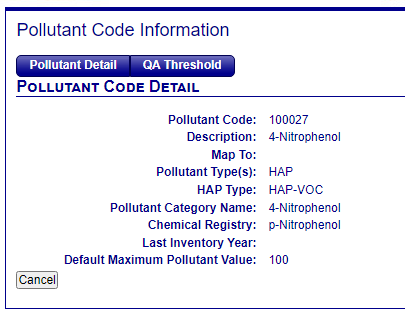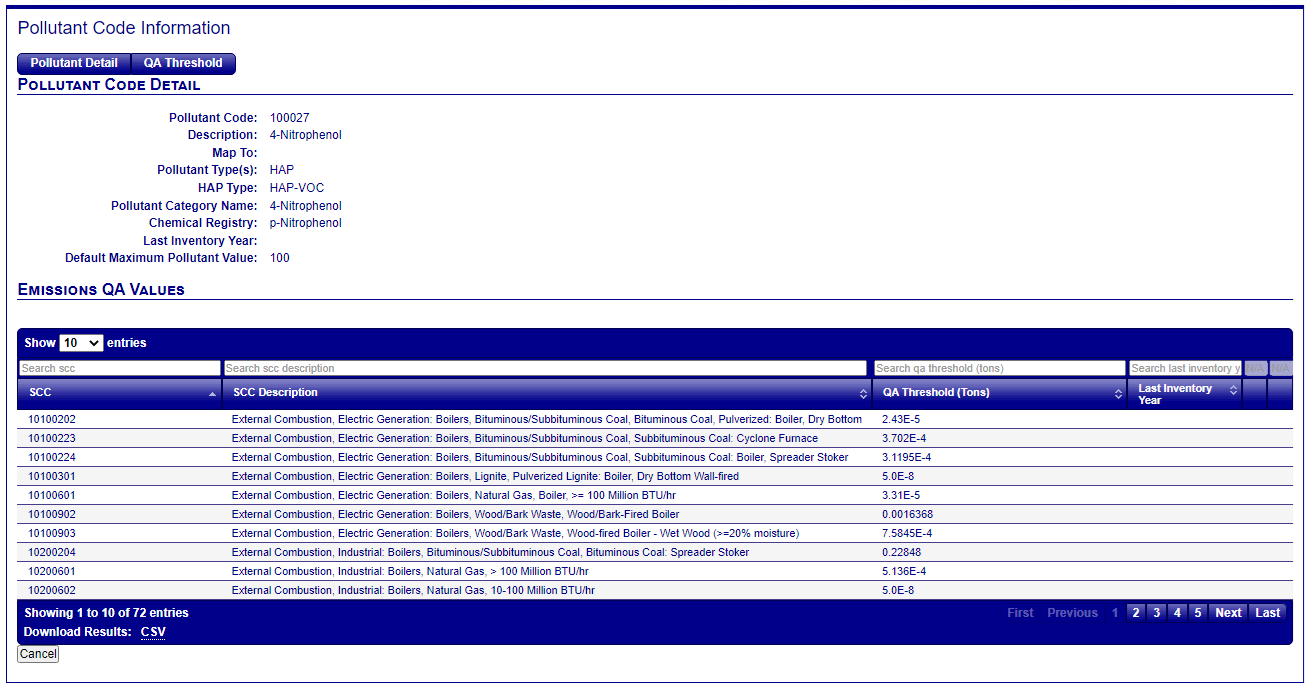Pollutant Code
Pollutant Codes
Users may view a list of all the current Pollutant Codes available for use in the Emissions Inventory System by accessing from the Reporting Code menu on the EIS navigation menu under Reference Data.

Select the Pollutant Code link from the Reporting Code Tables list to navigate to the Pollutant Codes table.


The Pollutant Code
The EIS Pollutant Code reporting tables list all the current Pollutant Codes available for use in the Emissions Inventory System. The list includes all the hazardous air pollutants (HAPs) identified by the EPA, as well as the Criteria Pollutants (CAPs) regulated by the Clean Air Act. Greenhouse Gas Pollutants are also identified, and HAPs are further broken down into HAP types to indicate if they are HAP-VOCs, Acid-Gases, or HAP-Metals. When emissions are submitted to the EIS, they must have a valid pollutant code, or they will be rejected.

The Pollutant Codes table includes the following information:
| Column Name | Description |
|---|---|
| Pollutant Code | The code that identifies the pollutant for which emissions are reported. |
| Description of Pollutant Code | The description of the pollutant for which emissions are reported. |
| Pollutant Types | Identifies the major grouping of the pollutant code. |
| HAP Type | The code that designates the Hazardous Air Pollutant categorization of the site. |
| Pollutant Category Name | List of pollutant categories used in the pollutant code table. |
| Last Inventory Year | The last inventory year in which emissions data could be submitted using a code value. |
| Map To | Identifies the reporting code that should be used instead of the specified code. In some cases, a code is retired or modified, and a new code should be used in its place. This field shows which code should now be used |
| Standard Unit of Measure | The unit of measure for the expected pollutant threshold value. |
| Default Facility Maximum Annual Emission | The maximum allowable amount for a pollutant by default. |
| Pollutant Synonym | The name U.S. EPA has selected as the preferred name for a chemical substance. |
| EPA Comptox Substance ID | The unique substance identifier for the pollutant used in EPA’s CompTox Chemicals Dashboard, which is sourced from EPA’s Distributed Structure-Searchable Toxicity (DSSTox) Database. This ID classifies chemicals based on biological processes they may disrupt. |
| SRS Internal Tracking Number | The name or identification of the pollutant code in SRS database. |
| Carcinogenic Inhalation Unit Risk (IUR) (per μg/m3) | The cancer health benchmark published in the EPA’s Human Exposure Model’s Chemical Health Effects Library. Also known as the inhalation Unit Risk Estimate, this health benchmark represents the upper-bound excess lifetime cancer risk estimated to result from continuous exposure to the pollutant at a concentration of 1 microgram per cubic meter (µg/m3) in air. For example, if the IUR is 1.5 x 10-6 per µg/m3, then 1.5 excess cancer cases are expected per 1 million people, if all 1 million people were exposed daily for a lifetime to 1 microgram of the pollutant in 1 cubic meter of air. |
| Chronic Noncancer Inhalation Reference Concentration (RfC) (mg/m3) | The chronic noncancer health benchmark is published in EPA’s Human Exposure Model’s Chemical Health Effects Library. The RfC is a concentration estimate of a continuous inhalation exposure to the human population that is likely to be without an appreciable “risk” of deleterious noncancer health effects during a lifetime, including to sensitive subgroups such as children, asthmatics, and the elderly. No adverse effects are expected to result from exposure if the ratio of the potential exposure concentration to the RfC, defined as the hazard quotient (HQ), is less than or equal to one (1). |
| Chronic Noncancer Target Organ | Target organs are those organs (e.g., kidney) or organ systems (e.g., respiratory) that may be impacted by chronic noncancer health effects from exposure to the pollutant in question, as published in EPA’s Human Exposure Model’s Chemical Health Effects Library. |
Pollutant Code Information
Clicking on a Pollutant Code link in the table will navigate you to the Pollutant Code Information page.

The Pollutant Code Information page allows you to select from two different tabs: Pollutant Detail and Acceptable Emissions Range.

Pollutant Code Detail
The Pollutant Code Detail provides additional information regarding the pollutant code.

Acceptable Emissions Range
The Acceptable Emissions Range tab will display the acceptable emissions ranges that are defined by the EIS for the Pollutant you are viewing and its SCC combinations.
